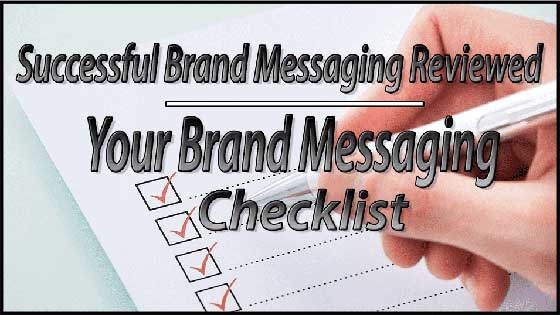The elements that make up brand messaging framework create the visuals and the voice of your brand. Going beyond an offering of a product or service, your brand is a big factor in the overall experience you want your audience to have when they meet and interact with your business. To give your target audience the opportunity to get familiar with you, you need to meet them where they are. By that I mean, your brand messaging needs to resonate with them in the context of their needs, wants, problems and it needs to be visible where they are (in-person, mobile, search, social).
Brand messaging Includes your:
- Name (Company name, domain name, URL, profile IDs)
- Logo
- Tagline
- Color
- Typography (font, style, format)
- Marketing messaging (slogan, mission statement, brand pillars, benefits, unique value proposition, web copy and other information available online about your company through third party sites like directory/social profiles.)
We’ve put together a complete brand messaging checklist to help guide you on your way to getting your brand in the limelight.
Table of Contents
ToggleWho Is Your Audience?
Know and understand your target audience
Your brand messaging must first and foremost speak to your target audience. Following some research, building buyer personas is a great place to begin focusing in on your ideal customer. Who are they? What are their interests? What are their pain points? Everything that follows needs to resonate with the audiences’ wants, needs, motivations, passions, interests, and pain points.
What Is Your Unique Value Proposition
Figure out what is unique about your offer. A unique value proposition is one of the most important elements because it is what differentiates you from everyone else in your market. What makes your offer unique from other similar product/service offerings? While remaining customer-centric, brainstorm what’s unique about your brand and offer that should inspire people to buy from you instead of a competitor. Determine several distinct advantages of purchasing through your business over others.
What Is Your Brand Promise?
Build your brand promise.
The process of forming a distinct brand promise is a must but, where do you start? Take a step back for a moment and think first, who does it matter to? You need to know who cares so you can identify a promise that fits your business and matters to the ones consuming your brand.
To build your brand promise, you need to look at your brand from three perspectives:
The Customer
Remember those buyer persona’s? Keep them top of mind, much of the work that goes into building a brand promise will be already done if you’ve taken the time to understand your ideal buyer.
- What is it about your brand that is unique from other brands marketing to them?
- What are their pain points?
- How does your brand solve their problems?
- What do they value?
For your brand promise to resonate, its’ got to convey the true value of what you’re offering.
Research consumer behavior in your market, interview customers, survey subscribers, interact with them wherever they are.
The Company
An internal perspective from everyone but, in the least, from the C-suite, sales team and customer service team will help guide the brand promise. These are the people who most often interact with customers, fielding questions and concerns.
Moreover, they chose to work with your company. What attracted them to you? Company culture can certainly influence brand messaging. Host a brainstorming session with your team to gather more information about your audience, internally and externally. After all, you’ve got to get your employees buy-in on the brand promise too.
The Marketplace
Put on your research cap and familiarize yourself with how your competitors are positioning their brand. When you set out to examine competitors brand messaging, do the following:
- Record their tag lines, slogans, mission statement
- Read their “About Us” page
- Check out their social profiles
Examining your competitors brand messaging can help you to see where there’s a gap in speaking to the needs of the audience, or other opportunity to take a unique approach to branding a similar product or service.
Develop Your Brand Slogan
Grab their attention.
Call it a tagline, slogan, or catch-phrase – the important point to remember here is that paired with your company name, your slogan needs to effortlessly communicate what you offer and indicate the value of your offer.
Where Is Your Brand Positioned
Determine your fit in the marketplace.
Brand positioning helps educate customers on what a brand wants to help them achieve and how they will add valuable meaning to their lives. The brand positioning is closely tied with the unique value proposition so as you think about these elements of your brand messaging, again – put yourself in the shoes of the ideal customer. Consider what will be of value for them to know so that a positive perception of your brand will result. Illustrate your shared values with the target audience, as well as understanding & empathy for their pain points. And finally, vision. Don’t exclude the consideration your long-term goals and visionary insights for the future of your brand when developing your messaging.
What Does Your Brand Stand For
Know your brand’s values.
Once you’ve got a good handle on your brand positioning, brand promise and mission statement put them all in front of you and boil them down to a few brand pillars or brand values. In one word each, they should essentially sum up the key values the brand shares with their target audience and wants to uphold throughout the entire buyers journey from attracting new visitors to delighting customers into brand advocates.
Know The Feeling You Want to Convey
Develop your brand’s tone.
Tone matters and there are several sources you can turn to, to begin honing in on the tone you need to convey to your audience through your messaging. Speak to your audience in a tone conducive to attracting them to you. The tone needs to support the brand message, not compete with or contradict it. You don’t want to scare off buyers with too much industry jargon, or an approach that feels masculine when your ideal customers are women. Explore some tone development resources and remember to have fun, you’re building a brand to convey how you can help satisfy the wants and needs of your customers.
Pitch Your Brand
Be prepared to get people excited about your brand in well under a minute.
Write a short and simple explanation of who your brand is and what you do, it should take you no more than about 45 seconds to recite naturally. If it’s too short, you might not be providing enough meat and potatoes to spark interest but, if it’s too long – then, you risk complicating your brand message and losing the attention of your listeners. Remember KISS: Keep It Super Simple.
Test it out when networking with your target audience, at industry conferences, with new friends over cocktails when you get asked the inevitable “what do you do for a living?” and with strangers in the grocery line – observe the reactions you get and the questions that follow, if any. The reactions, especially from those who fit into your target audience demographic can be very helpful in guiding how you may adjust your verbiage and tone to appeal more to the people you’re trying to attract.
Back Up Your Brand Authority
Collect genuine testimonials, invite people to leave a comment or review, & showcase case studies,
Online reviews, testimonials, case studies and examples both on and off your website speaking to how your product/service helped someone solve a problem are powerful and supportive tools for your brand messaging. They help shed light on the human aspect of your brand and are strong trust signals for newcomers who may want to purchase but, seek out feedback from other sources before making a buying decision.











